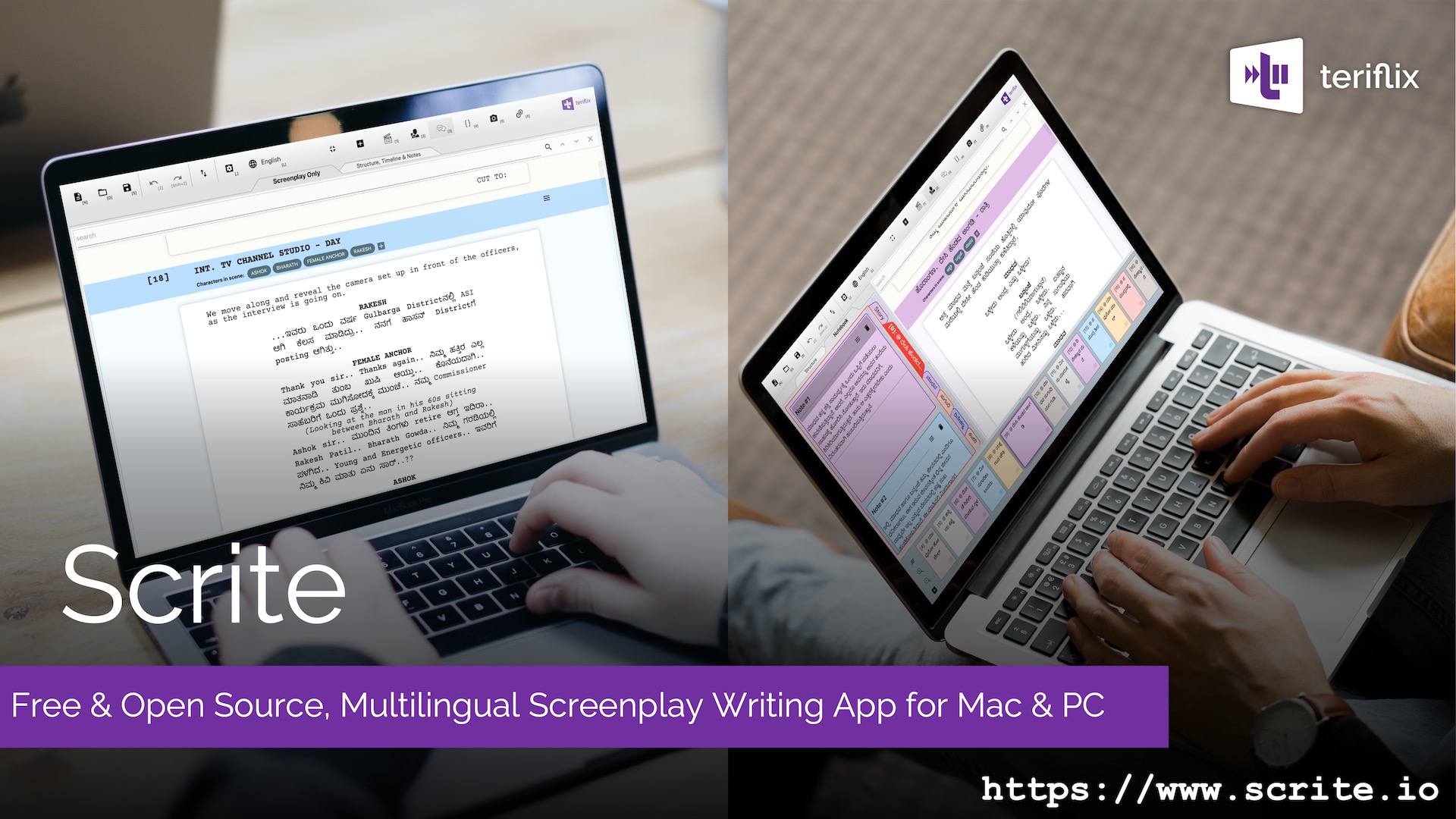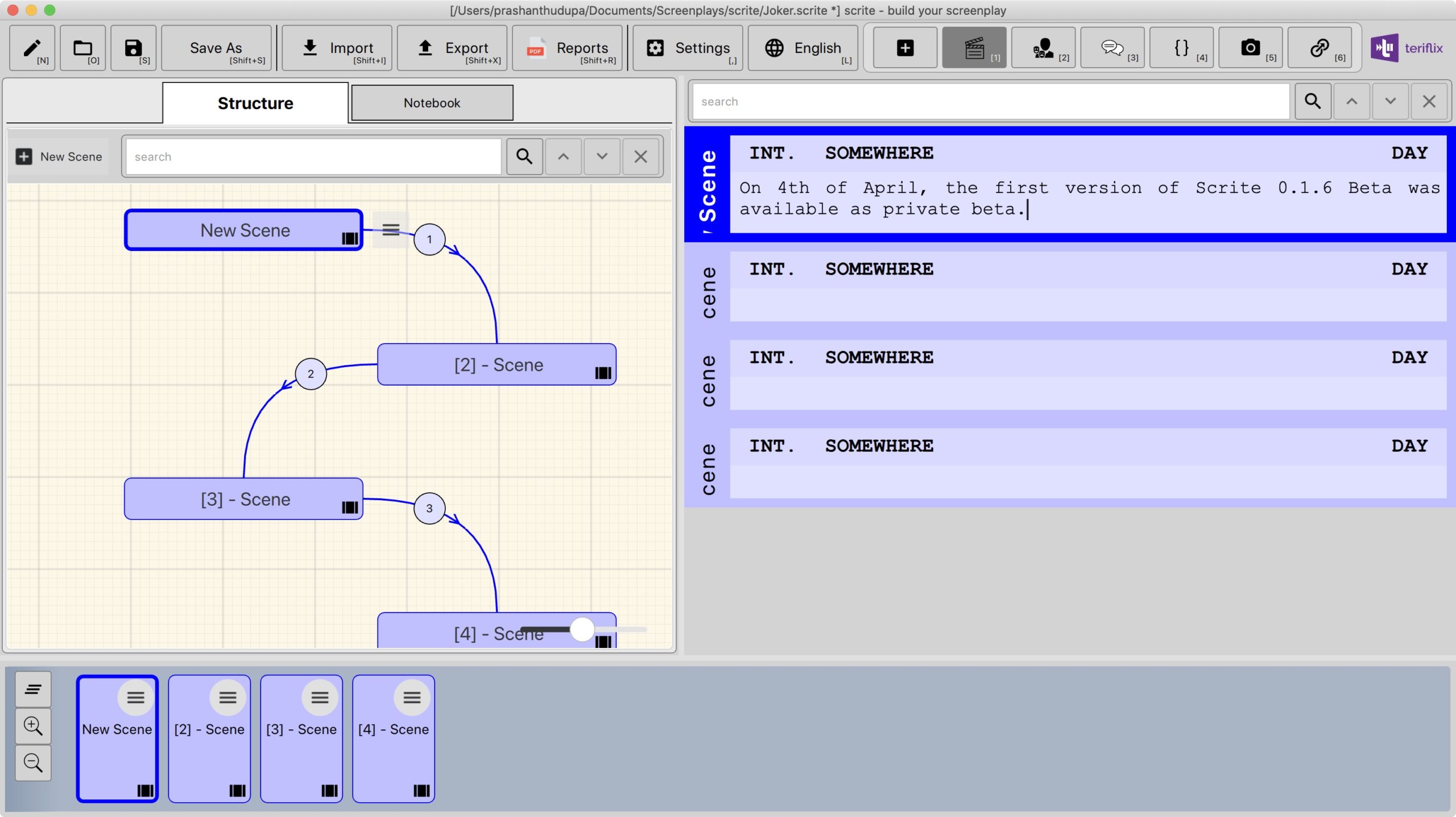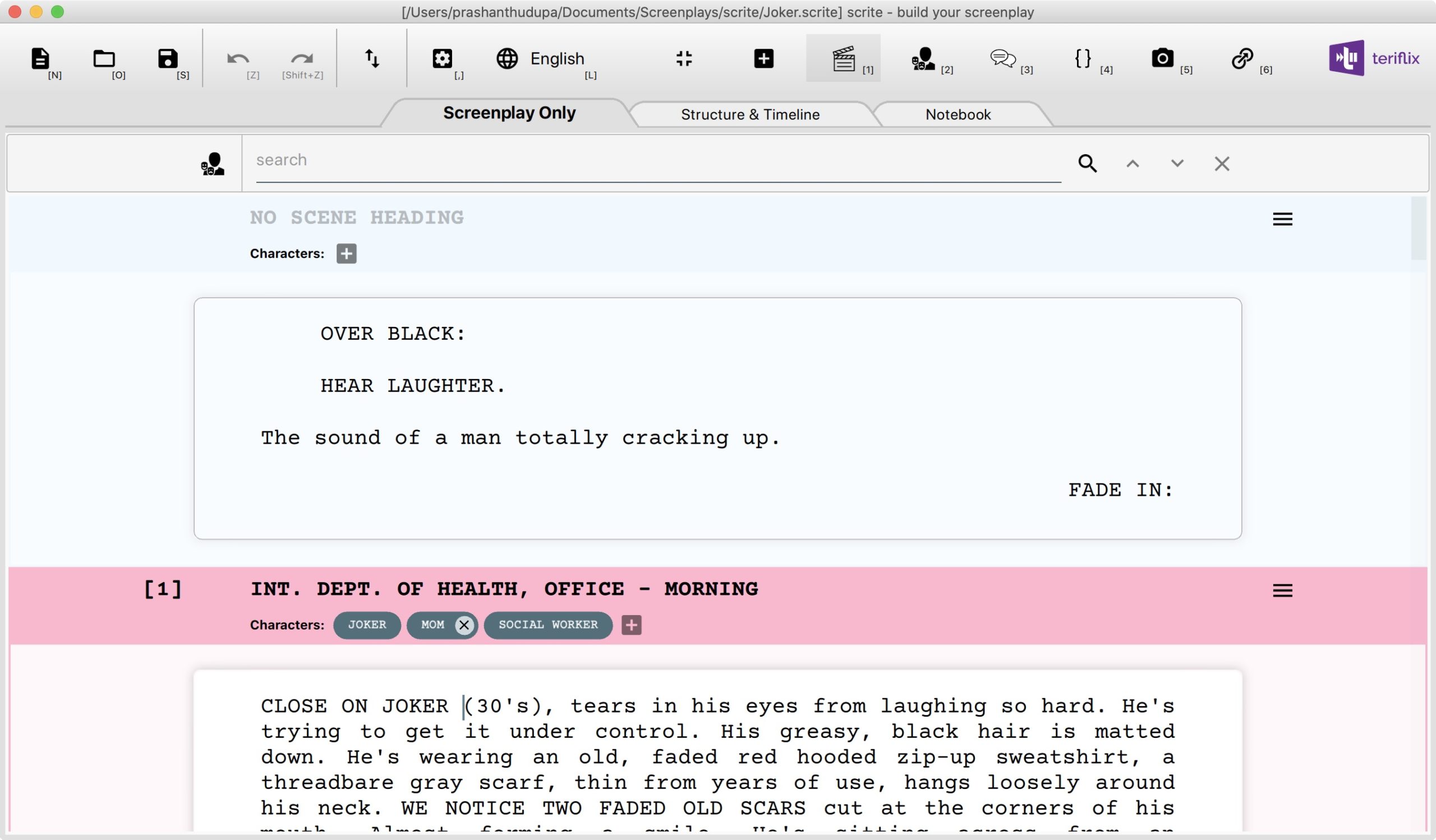This is the story of how Scrite, the free and open source multilingual screenplay writing app came to be.

Sometime in December 2019, I started trying my hand at writing screenplays. For a few months, until the beginning of March 2020, I was writing something almost every single day. I finished writing 3 screenplays and was even fortunate to get solid quality feedback on one of them from Director Abhaya Simha and for another one of them from Director Rohit Padaki and Director Pradeep Varma. I got serious about one of my screenplays, I started rewriting it in an attempt to incorporate all of the feedback.
While rewriting, I started to feel that the app that I was using was not keeping up with the way in which I was imagining the story. In my head stories show up in a particular shape. More specifically, the story shows up as an arrangement of elements, which arrangement has a shape. This is what I would like to call structure. A specific way of sequencing elements from the structure is what I would call screenplay. While the existing apps helped me with writing the screenplay, I couldn’t find anything that helped me capture the structure.
I thought of writing a simple desktop app, just for my own use, to capture the structure of my story in addition to help me with the writing of the screenplay itself. I kept procrastinating it until on 24th March 2020, when Prime Minister Modi announced the first lockdown in the wake of #COVID19 pandemic. I was in my father-in-law’s house in Shimoga at that time. The 21 day lockdown meant that I would simply be unable to return home. Thankfully I had taken with me my Mac, which meant I could continue to work on the rewrite of my screenplay. But something in me pushed me to work on building the app instead. Now, when I look back – I think it was a god-sent-blessing that I was in my in-laws house during the 21+14 day lockdown. My in-laws, my wife and son gave me the much needed space required to put together this app in such a short period of time.
I started writing the first bits of code for the app on the morning of 25th March 2020. I used Qt as the software framework for writing the app, because … well what else would I use? By evening I had given it a name: Scrite.
Within 5 days, I had a working app which I could use to write full screenplays. I imported my previous screenplays into Scrite and was able to immediately notice the difference that it would make. I gave a demo of the app to Praveen Udupa. He loved it. He had a lot of early critical feedback, but in general he loved the app and the direction it was taking. Ever since I gave the first demo of the app to him, he has been putting together some really cool ideas for the future of Scrite. Much of which we cannot talk about now, because we don’t have the basics in place. But there are some really cool ideas for the future.
Out of excitement, I shared a few screenshots of the early version of the app with Director Abhaya Simha. He was very excited to see it. I told him that I was going to use my app to rewrite the screenplay that he had given me feedback on. He advised me that rather than using it privately, it would be useful to let other people use it. But he was very particular that the app had support for writing in Kannada. He said that while there were several screenplay writing apps for English, people had to make do with Word for writing in Kannada OR write Kannada elsewhere and copy/paste it into apps like FinalDraft etc. Ofcourse, one could use IME apps from Baraha, Nudi etc. He still felt that having Kannada writing backed into the app would make a lot of difference.
I called up my friend Lohith D. S who has written the popular Kannada Notepad app called Pada. Lohith and I were classmates during our Engineering course at JNNCE, Shimoga. We were also colleagues for a while at VCreate Logic, before he chose to move on to other opportunities. Since he had experience with writing Qt apps that supported typing in Kannada, I spoke to him and asked for advise. Over phone he gave me a 20 minute explanation, because of which I got the basic idea and then a simple Google Search later, I found out about the PhoneticTranslator project on SourceForge. In just a few hours since then, I was able to incorporate PhoneticTranslator and start typing in Kannada within Scrite.
In just over a week, on 4th April 2020 I had a working Beta using which I could capture a rudimentary structure and also type out the screenplay. Over the next few days, my cofounder at TERIFLIX, Praveen Udupa and I decided to make this a TERIFLIX app.

I sent a copy of the app to Director Abhaya Simha. He took it for a spin and gave me feedback to help make it better. I started incorporating all that feedback into the app.
I had also requested feedback from my friends in the Aarohi Open Learning community, specifically from Aditi and Aswathy Ajesh (who is a young learner at Aarohi). All of their feedback helped make the app so much better than I could have done by myself.
My cousin brother Sujith Udupa, who is a budding theater artist and music composer, also helped test and fine tune the early builds of the app.
During the time I was working with Director Simha on the feedback, I also showed the app to Director Adarsh Eshwarappa. He was also very excited to see the app. Since he is a Windows user, I had to make a Windows build for him.
I installed Parallels for Mac, installed a license of Windows 10 on it, downloaded Microsoft Visual Studio 2017 and Qt for Windows and set it up on the Windows 10 VM. All of this had to be downloaded using my Airtel 4G connection, because I was still in my in-laws house and they don’t have WiFi. It took a few days to set it all up. But once I got setup, I was able to send the first Windows build of Scrite to Director Adarsh Eshwarappa on 14th April 2020, the last day of Lockdown 1.0. He took the first Windows build, version 0.2.4 Beta, for a spin on his PC and gave me quality feedback. He also offered to give me the original screenplay of Shuddhi (written using Celtx) which I could then import into Scrite. We have sine also been fortunate to publish the entire screenplay of Paddayi as well.
While I was showing the app to Director Adarsh Eshwarappa, I had also given a Windows build to Director Pradeep Varma and requested him to use it and give feedback. He was so generous with his time and feedback, I was super thrilled.
I began learning about writing screenplays when I took my first screen-writing workshop with Director Rohit Padaki about 2 years ago. I just had to show the app to Director Padaki and take his feedback. He was also very encouraging. His feedback helped shape some of the early features in Scrite.
Armed with the positive vibes that I was getting for the app from Director Abhaya Simha, Adarsh Eshwarappa, Rohit Padaki and Pradeep Varma, Praveen & I decided to release a public beta on 17th April. By then Prime Minister Modi had put Lockdown 2.0 into motion. I had to stay back at Shimoga until 4th May.
Our first public beta was released on https://scrite.teriflix.com. Along with the first public beta, I put the entire source code on GitHub and released the app’s code under GPLv3 license and also recorded a quick video tutorial. A few days later I put together a dedicated website for the app at https://www.scrite.io.
While all this was going on, I recorded a video episode with Director Simha about Scrite and published it. Praveen & I recorded another video episode with Director Eshwarappa also. Coupled with a rather elaborate user guide, I think we had everything required to let people test drive the app without even having to install it. Many writers who read about the app and watched the videos we made also downloaded, installed the app and sent us early feedback.
Within the first 4 days since the launch of our first website, we got over 3500 hits to our website. I had not put together any mechanism to track downloads, bummer – I know!
When the new website was put together, I had a statistics module in place. As of today, according to the statistics we have gathered from our new website, over 400 people have downloaded Scrite of which roughly 150 are active users. We know of at least 5 people who have pulled the code from GitHub and compiled it on their Linux and 32-bit Windows platforms. There may be more, we don’t know.
Shilpa Sebastian at The Hindu published an article about Scrite, which got us our first media mention. Within 2 days of the article being published on The Hindu, we got 60 more users!!
The app has been getting regular updates since its first release on 17th April 2020. You can read all about it in the News section of the Scrite website. Many people came forward to help us with testing and feedback. We are still in Beta phase and it will be a while before we release a master 1.0 version. There are a few more critical features in mind, but more importantly the app needs more testing and QA love before we can release a master 1.0 version. [Fun fact: one of the key testers of the app is my 9 year old son Advay. He spends a few hours every week testing the app, reporting crashes and ensuring that the bug fix actually works.]
I am super happy to see such good adoption of the app. On 25th March 2020, when I began writing the code for a private-use-only-screenplay writing app; little did I know that within hardly two months over 400 people would download the app and try it out. We are getting a lot of suggestion, bug reports and appreciation mail from writers and open-source users all around the world. Its awesome that people are comparing this app with the kind of features they are used to in Final Draft. I had never ever in my wildest dreams thought that I would write a Screenplay app that people would compare and contrast with Final Draft. I mean THE FINAL DRAFT!!!! Its all a bit too dreamy for me.
Yesterday, I downloaded the screenplay of Joker from IMSDB and imported it into Scrite. The writing is top notch and I love being able to observe that in Scrite.

Until now, all our apps are released unsigned. Our users have to bear the warnings posted by their Operating System to install and use the app. Starting next week, all builds of Scrite will be signed.
We also have some super-cool features coming up within the Structure tab of the Scrite app. We have only just started. I think there is a lot of potential for the app and future services we could bundle along with it.
Quick Bit: There is going to be an Android App at some point. Possibly iOS also.
In the past few weeks, I have been in constant touch with Punit Thakkar, a content and technology consultant in Mumbai, to help catapult the app into relevance among regional writers in India, to begin with. Together with some of the new ideas that Director Abhaya Simha, Director Adarsh Eshwarappa, Praveen Udupa and I are coming up with, we have an exciting road ahead for Scrite.